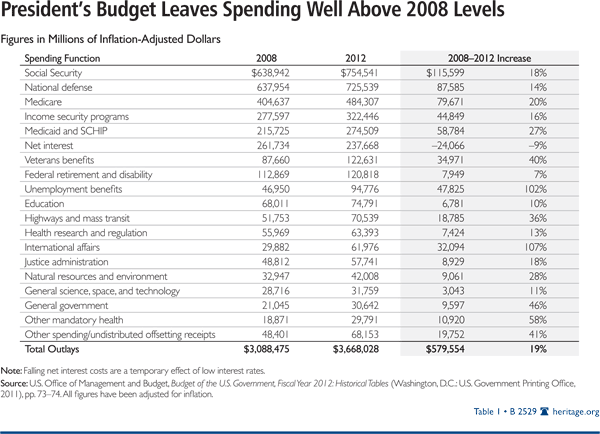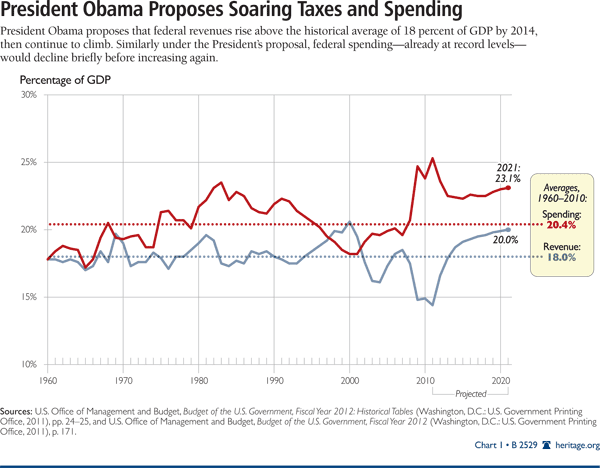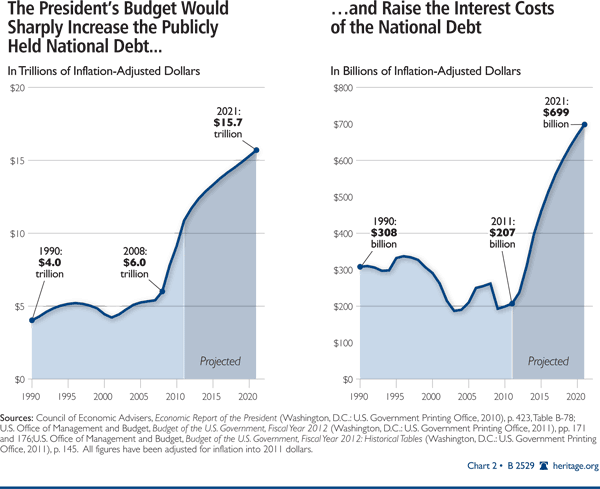Abstract: In his 2012 budget proposal, President Obama uses lofty rhetoric about fiscal realities and hard choices—and proceeds to give the green light to yet more spending, yet higher taxes, and skyrocketing debt. His budget fails to reform uncontrollable entitlements, is overly timid on non-defense discretionary spending, and is loaded with gimmicks and baseless assumptions. Any responsible budget must now rein in spending and deficits. Heritage Foundation budgetary expert Brian Riedl lays bare the realities of the President’s new budget.
The first page of President Barack Obama’s fiscal year (FY) 2012 budget proposal states that “the fiscal realities we face require hard choices,” and that “the chronic failure to confront difficult decisions has put us on an unsustainable course.” Ironically, the President’s budget continues this refusal to confront difficult decisions. Despite the President’s rhetoric of restraint, his budget would push spending, taxes, and debt to historic levels, placing America’s economic future at grave risk. The President’s budget proposes:[1]
- Permanently expanding the federal government by 3 percent of gross domestic product (GDP) over 2007 pre-recession levels;
- Raising taxes by $1.6 trillion over the next decade;
- Running a $1.6 trillion deficit in 2011—the highest in American history in nominal dollars, and the highest since World War II as a percentage of GDP;
- Borrowing 43 cents for each dollar spent in 2011;
- Doubling the national debt over pre-recession levels;
- Dumping an additional $66,000 per household of debt into the laps of our children and grandchildren; and
- No significant reforms to Social Security, Medicare, and Medicaid.
Before the recession, Washington spent $25,000 per household annually. President Obama has already pushed spending above $30,000 per household, on its way past $35,000 within the next decade[2] (even higher if not counting the budget’s many spending gimmicks). The President’s budget fails to meet his own pledge to cut the deficit in half during his first term.[3] After an election in which voters expressed disgust with business-as-usual spending and deficits, President Obama has proposed more of—almost exactly—the same.
The President has stated that significantly cutting federal spending now would endanger the fragile economic recovery. Setting aside his disproven assumption that government spending buys prosperity, [4] there is no reason he could not propose a phase-in of entitlement reforms as the economy recovers. Indeed, such proposals would likely encourage the recovery by giving the markets confidence that Washington is finally addressing its structural budget deficit. Instead, President Obama wants to continue his unaffordable spending spree, with no end in sight.
Runaway Spending Drives Deficits
President Obama regularly disowns his own budget deficits, claiming they were inherited from his predecessor. However, President George W. Bush’s deficits averaged $415 billion over eight years in office, while President Obama proposes deficits averaging $952 billion over eight years.
Furthermore, when President Obama took office in January 2009, the Congressional Budget Office (CBO) forecast a baseline budget deficit of $2.9 trillion between 2010 and 2018.[5] President Obama has now proposed running $8.0 trillion in deficits over that period.
The President also blames his deficits on the recession. This made sense in 2009, when the recession played the lead role in growing the budget deficit to $1.4 trillion. If recessions expand budget deficits, recoveries should shrink them. Instead, two years after the economy hit bottom, the deficit continues to rise, to $1.6 trillion this year. And even after a return to (assumed) peace and prosperity, the President’s own 10-year figures show annual deficits that never fall below $600 billion.
Escalating spending is worsening the short-term deficits. Under the President’s budget, 2012 federal spending would remain well above the 2008 level he inherited. Table 1 shows examples of large inflation-adjusted increases over that period, including international affairs (107 percent), unemployment benefits (102 percent), general government (46 percent), veterans benefits (40 percent), and highways and transit (36 percent). The only significant spending decrease has been in net interest on the debt—a result of temporarily falling interest rates that will soon reverse.
Long-term deficits are driven exclusively by runaway spending, not by low revenues. Before the recession, revenues and spending stood at their historical averages of 18 percent and 20 percent of GDP, respectively. Although the recession has temporarily reduced revenues, they are projected to return to 18 percent of GDP once the economy recovers, even if all 2001 and 2003 tax cuts are extended, and the Alternative Minimum Tax “patch” continues.[6] President Obama proposes raising taxes to 20 percent of GDP (an additional $3,500 per household, adjusted for inflation) not to reduce the deficit, but to partially finance a federal spending increase to 23 percent of GDP—or even more if certain budget gimmicks are removed. At that point, both revenues and spending would be at their highest sustained levels in American history (see Chart 1).[7]
As deficits continue to pile up at historic levels, the national debt held by the public—$6.0 trillion when President Obama took office—would reach $15.7 trillion by 2021, and the annual net interest cost on the national debt would triple (see Chart 2).
Punting on Entitlements
I’ve called for a bipartisan fiscal commission, modeled on a proposal by Republican Judd Gregg and Democrat Kent Conrad . This can’t be one of those Washington gimmicks that lets us pretend we solved a problem. The commission will have to provide a specific set of solutions by a certain deadline. Yesterday, the Senate blocked a bill that would have created this commission. So I will issue an executive order that will allow us to go forward, because I refuse to pass this problem on to another generation of Americans.
—President Obama, State of the Union Address, January 27, 2010[8]
It is well known that the unsustainable growth of entitlement spending risks bankrupting the federal government. Annual spending on Social Security, Medicare, and Medicaid is projected to rise from $1.4 trillion to $2.7 trillion over the next decade,[9] and the CBO projects that maintaining all promised benefits would eventually require putting the middle class in a 63 percent income tax bracket, and small businesses and upper-class families in an 88 percent bracket.[10]
In response, the President who “refuse[s] to pass this problem on to another generation of Americans” did exactly that. He not only failed to offer any significant entitlement reforms, he even ignored the modest recommendations of his own deficit commission. This prompted Democratic deficit commission co-chairman Erskine Bowles to declare that the President’s budget is “nowhere near where they will have to go to resolve our fiscal nightmare.”[11] The Washington Post dubbed the President the “Punter-in-Chief.”[12] An incredulous Senate Budget Committee Chairman Kent Conrad (D–ND) added that the budget proposal “puts at risk the economic security of this country,” and “cannot be the answer for this country’s fiscal future.”[13] Entitlement reform is the largest economic challenge of this era, and to offer no solutions represents a complete failure of presidential leadership. Putting off these inevitable reforms will ultimately make them more expensive—and more difficult to implement.
Discretionary Spending Timidity
The President has received significant attention for his proposal to freeze non-security discretionary spending for the next five years. While this proposal is certainly superior to the all-too-common budget increases, it is less ambitious than meets the eye. Non-security discretionary programs comprise just one-tenth of federal spending. The proposed freeze merely locks in the 25 percent increase these programs have received since 2007 (they also received $311 billion in one-time stimulus funding), at a time when fiscal reality demands cutting spending and eliminating failed programs. Compared to a baseline where spending otherwise grows at the inflation rate, the freeze proposal would save just $40 billion annually—less than 1 percent of the federal budget over the next decade.
President Obama claims that this freeze will reduce non-security discretionary spending as a share of the economy to the lowest levels since the Eisenhower Administration. However, discretionary spending is written from scratch each year. So unless the President also proposes multi-year statutory spending caps, all discretionary spending figures after 2012 are simply placeholders. The President is essentially claiming credit for budget cuts that may or may not be enacted by future Presidents and Congresses.
Given that, the President found an ingenious way to reduce projected discretionary spending to 1950s levels: by simply reclassifying highway spending and a portion of Pell Grants as entitlement spending. It is like an old headline from the spoof newspaper The Onion: “Eight Million Americans Rescued from Poverty with Redefinition of Term.” By the President’s logic, the government could slash entitlement spending immediately simply by deciding to no longer count Medicare as an entitlement.
Nearly $2 Trillion in Gimmicks
All presidential budgets contain some gimmicks. Yet the President who promised “a return to honest budgeting”[14] has produced perhaps the most gimmick-laden budget in memory. Budgets typically begin by setting a budget baseline—a default 10-year budget blueprint reflecting the extension of all current spending policies and tax policies—and then offering new proposals to alter that baseline. President Obama’s budget, however, hides multiple new policies and assumptions within the baseline itself, such as (over the next decade):
- $800 billion in tax increases from allowing the 2001 and 2003 tax cuts to expire for small business and upper-income individuals;
- $118 billion in additional Pell Grant entitlement spending; and
- $1.7 trillion in additional projected tax revenues resulting from economic assumptions much more optimistic than those of the CBO or Blue-Chip forecast.[15]
From that baseline, the President claims $2.2 trillion in deficit reduction over the decade. However, most of this deficit reduction is based on “magic asterisks” rather than specific, measurable policies. President Obama’s FY 2012 budget:
- Claims to finance a $328 billion transportation trust fund—without specifying which tax would pay for it (and takes gas tax increases off the table);
- Takes credit for $321 billion in spending cuts to offset the cost of the Medicare physician payment “doc fix” from 2014 through 2021—without specifying any spending cuts;
- Claims more than $150 billion in “program integrity” savings so vague that the CBO did not score them in past presidential budget estimates;
- Takes credit for $700 billion in defense “cuts” by comparing the long-planned drawdown of Iraq and Afghanistan spending against a baseline that implausibly assumes those costs would rise forever; and
- Assumes $200 billion in net interest savings from the above “deficit reduction.”
So while there is some legitimate deficit reduction, $1.7 trillion of the $2.2 trillion in claimed savings are pure gimmicks and magic asterisks. Of course, the proposed spending increases—the Medicare doc fix, new transportation spending, high-speed rail, more Pell Grant entitlements, and another round of $250 checks for senior citizens—are all real and scoreable.
A Better Way Forward
President Obama has offered a budget that does nothing to address the nation’s serious short-term and long-term fiscal problems. Strip away all the magic asterisks and gimmicks, and what remains is a budget too similar to the President’s previous tax-borrow-and-spend budgets. It raises taxes by $1.6 trillion, and keeps spending at its highest sustained level since World War II. By doubling the national debt above pre-recession levels, America could be heading toward the tipping point where debt levels become too large for global capital markets to absorb, potentially triggering a financial crisis, an interest rate spike, and crippling tax increases.
Countries that finance U.S. debt will note that President Obama’s budget includes no plan for long-term fiscal sustainability. The President who declared that “I didn’t come here to pass our problems on to the next president or the next generation—I’m here to solve them,”[16] would, over the next decade, drop an additional $66,000 per household in debt into the laps of our children and grandchildren.
A responsible budget must rein in runaway spending and deficits. It must immediately bring non-defense discretionary spending down to pre-recession levels or lower. It must pare back lower-priority spending so that the nation’s vital defense needs are not under-financed.[17] It must reject devastating tax increases during a fragile recovery, and instead cap the growth of government spending at a reasonable rate. Most important, a responsible budget must propose specific reforms to address the unaffordable Social Security, Medicare, and Medicare spending trends.[18] Congress’s budget should aim to meet these standards—even though the Obama budget fails to do so.
—Brian M. Riedl is Grover M. Hermann Fellow in Federal Budgetary Affairs in the Thomas A. Roe Institute for Economic Policy Studies at The Heritage Foundation.






